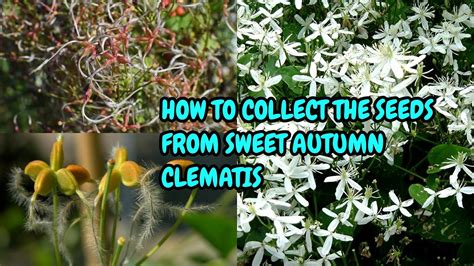How To Collect Clematis Seeds
Ronan Farrow
Mar 31, 2025 · 3 min read

Table of Contents
How to Collect Clematis Seeds: A Gardener's Guide
Clematis, with their vibrant blooms and climbing prowess, are a beloved addition to any garden. Propagating clematis from seed can be a rewarding experience, offering a cost-effective way to expand your collection and potentially cultivate unique varieties. However, successfully collecting and sowing clematis seeds requires patience and attention to detail. This comprehensive guide will walk you through the process, ensuring you're well-equipped to harvest and nurture these tiny treasures.
Identifying Mature Clematis Seed Heads
The first step in collecting clematis seeds is identifying mature seed heads. This is crucial because only mature seeds are viable. Look for seed heads that have:
- Turned brown or a silvery-grey: This indicates the seeds inside have fully developed. Green seed heads are not yet ready for harvesting.
- A dry, papery texture: The seed head should feel dry and brittle to the touch, signifying the seeds are mature enough for collection.
- Slightly opened or drooping: As the seeds mature, the seed head might slightly open or droop, revealing the feathery seed tails.
Don't rush the process! Allowing the seed heads to fully mature on the vine ensures the highest germination rates. Patience is key when collecting clematis seeds.
Harvesting Clematis Seeds: A Step-by-Step Process
Once you've identified mature seed heads, it's time to collect them. Follow these steps for optimal results:
1. Gentle Harvesting
Carefully snip the mature seed heads from the vine using sharp pruning shears. Avoid damaging the seed heads during the harvesting process.
2. Air Drying
Place the harvested seed heads in a dry, well-ventilated area for several weeks. This allows the seeds to fully dry and the seed pods to open naturally. You can lay them out on paper or a mesh screen.
3. Seed Extraction
Once completely dry, gently rub the seed heads to release the seeds. Clematis seeds are typically attached to a feathery appendage, known as a pappus. These fluffy tails aid in wind dispersal in nature.
4. Seed Cleaning
Separate the seeds from any remaining plant debris. You can use a fine sieve or gently blow away any lightweight fragments. Store the cleaned seeds in a cool, dry place in a paper envelope or airtight container labeled with the clematis variety and collection date.
Storing Clematis Seeds for Optimal Germination
Proper storage is critical for maintaining seed viability. Clematis seeds benefit from a period of stratification, mimicking the natural conditions they experience in the wild before germination. This process involves exposing the seeds to cold temperatures, typically between 33°F and 41°F (0°C and 5°C) for several weeks or months.
While you can achieve this through cold stratification, keep in mind that clematis seeds often germinate best when sown directly into the ground in the fall for a natural winter chill.
Sowing Clematis Seeds: Tips for Success
Once you've collected and stored your clematis seeds, it's time to sow them. Remember that clematis seeds have a notoriously low germination rate, and success often requires patience.
- Timing: Sow seeds in the fall or early spring.
- Location: Choose a sunny spot with well-drained soil.
- Depth: Sow the seeds shallowly, barely covering them with soil.
Collecting clematis seeds is a rewarding journey for any dedicated gardener. By following these steps and remaining patient, you'll be well on your way to cultivating your own beautiful clematis from seed. Remember that success isn’t guaranteed on the first try; it's a process of learning and refinement. Happy gardening!
Featured Posts
Also read the following articles
| Article Title | Date |
|---|---|
| How To Fix P2609 Cummins Code | Mar 31, 2025 |
| How To Get A New Jeep Key Fob | Mar 31, 2025 |
| How To Get A No Trespass Order In Iowa | Mar 31, 2025 |
| How To Decorate A Console Table For Christmas | Mar 31, 2025 |
| How To Get A Legal Separation In Sc | Mar 31, 2025 |
Latest Posts
-
How Do Electric Skateboards Work
Apr 04, 2025
-
How Do Dual Zone Hvac Systems Work
Apr 04, 2025
-
How Do Dentists Remove A Crown
Apr 04, 2025
-
How Do Defensive Coordinators Call Plays
Apr 04, 2025
-
How Do Deer Find Corn
Apr 04, 2025
Thank you for visiting our website which covers about How To Collect Clematis Seeds . We hope the information provided has been useful to you. Feel free to contact us if you have any questions or need further assistance. See you next time and don't miss to bookmark.
